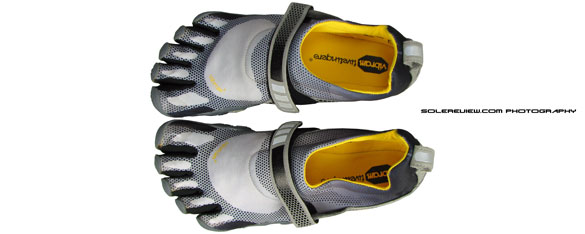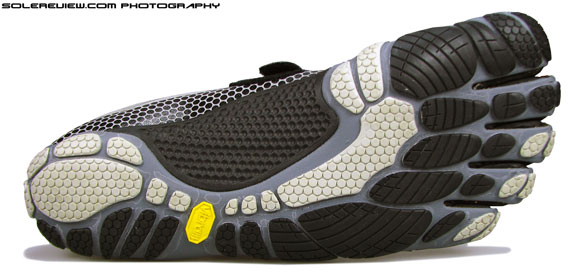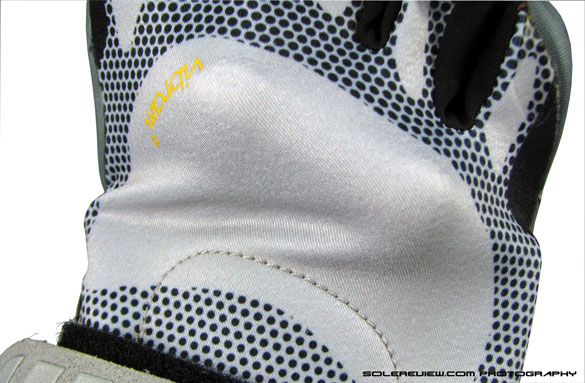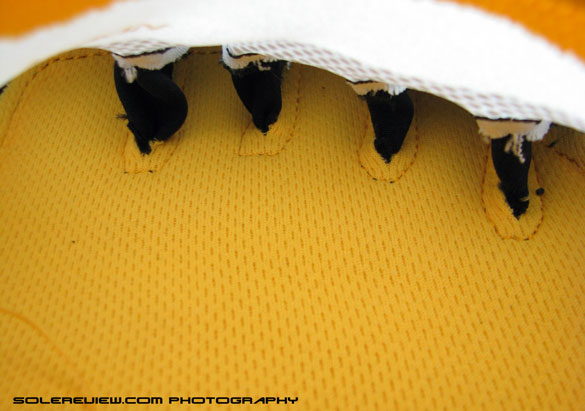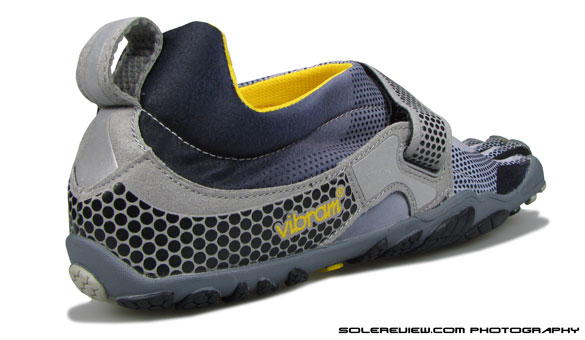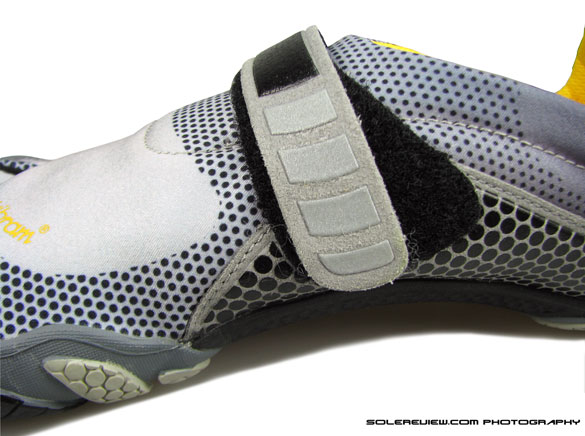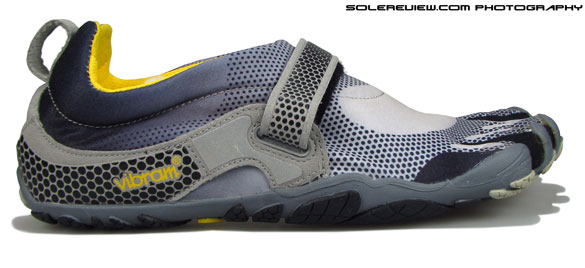The Bikila was launched in April 2010, and it is an important shoe in the Five Fingers evolution because it was the first to be designed specifically for running. How does it differ from the Classic outsole design? The Bikila outsole features multiple placements of lugs on the surface, compared to the uniformly contoured surface of the Classic. This, Vibram points out, was designed to have the Bikila offer more traction over a variety of surfaces. The name of the shoe was inspired by Adebe Bikila, the Ethopian runner famous for winning the 1960 Olympic marathon while running barefoot.
A hard, compression molded EVA foam piece sits beneath arch area, reducing the weight by replacing the area which was previously rubber. Up in the front, the outsole is divided into five different units, meant to individually accomodate all toes of the foot. The upper is a fairly straightforward affair; a one piece stretch Polyamide fabric covers the foot. It is closed around the collar area, but since the upper is slightly stretchy, the foot gets inside with little fuss. The collar is back padded with foam but only on the sides and along the Achilles lining. The area over the foot instep (where the tongue in a conventional shoe usually is) has a lighter grade of foam sandwiched between the layers. That partially deadens the top down pressure of the fastening strap, which runs over and across the foot.
The upper sits very snugly over the foot without any gaps. There was a feedback from the market on the relatively tight fit, so Vibram followed the Bikila up with the LS (lace) version, which allows for foot with bigger instep (waist) to wear the Bikila. But we faced no issues with the original fit so we preferred to buy the original Bikila, which has a cleaner look. We used Injinji five toed socks to test the Bikila in, but at the same time the Bikila fits and feels great without socks.
For anyone new to the Bikila or any Five Fingers shoe for that matter, even the simple act of on putting the shoes has a learning curve. The trick is to smoothly get each of the toes into individual upper sleeves. The upper splays the toes wide when worn, so during the initial days the smaller toes will tend to stick together. It does take a few wearings to get it right. The Bikila also gives the visual impression that only anatomically perfect toes can fit into them but we’d like to ally such fears. We tried the Bikila on a foot with model proportions – a gradual tapering off from the big toe to smallest, with normal arch and instep height. We observed that while the sleeve for the big toe is true to size, there is lot of room for the other toes. So if your foot happens to have a second toe which is longer than the big one, the Bikila should fit you with no difficulty at all.
The top of the toe sleeves is covered with translucent urethane, but the overall protection is very limited. Walk or run carefully in the Five Fingers, because even bumping a small rock will transmit a jarring force to the toes, which needless to say, is painful.
The sides of the heel and mid foot have thick synthetic layered overlays, and part of that extends to the heel pull tab. The velcro coverage under the strap is generous, allowing for a wide range of fastening levels. Reflective strips are printed on the end of the strap, with more visibility elements on the side and back of the heel. Structurally and aesthetically, the Bikila pushes the boundaries of footwear design. It looks like nothing else ever made – the 1997 Nike Air Rift comes close though, with its split toe design.
And when it comes to running in them, no shoe has divided social opinions more than the Five Fingers have. Some runners swear by the Five Fingers, attesting that it has cured all the foot problems they’ve ever had. On the flip side, many claim that they’ve had nothing but injuries after running in the VFF. So what should you believe, and should you get a pair of Vibram Five Fingers? The truth is that the Vibram Five Fingers shoe is not a toy to be trifled with. Many runners who stepped out of the Five Fingers as quickly they bought them, are likely to have done so because of the injuries caused by running in them. And why did they get injured? The likely reason is that they did not wait for they body to get used to the Vibrams, and made no change to their running style after transitioning from conventional shoes.
A study in 2007 [6] documented actual foot strike patterns across 283 runners in an elite half marathon, and it was observed that 75% of the runners rear foot striked (RFS). The analysis also concluded that foot strike patterns are related to running speeds, and a decrease in speed will lead to increased RFS. Given that the percentage of recreational runners far exceed forefoot striking sprinters and the occasional elite distance runner, it sounds logical that the majority of the runners will rear foot strike. Vibram knows that, so it recommends a change of foot strike when running in the Five Fingers. But what happens when a recreational, rear foot striking runner switches to doing miles in a pair of Vibram Five Fingers, without any change in foot strike pattern?
To find out, we conducted a test. A rather perilous one at that.
Our wear-test subject for the Bikila Five Fingers was an injury-free rear foot striker who did around 25 miles a week, 5’ 9”, 165 pounds, 9-10 minute/mile – ideal sample for a recreational runner. The subject also regularly performed exercises which focused on plantar and Achilles flexion, with optimally developed leg muscularity. Had been running in a variety of shoes, ranging from traditional neutral running shoes to contemporary, low drop minimalist footwear. But had never worn and run in a pair of Vibram Five Fingers Bikila.
And just like that, we cut our enterprising runner loose in the VFF for a 5k run. The run lasted just over 25 minutes, and here is a summary of the brief wear-test experiment. Some are very obvious points, but given the misconceptions floating around, it is better to list everything:
a) Running in the Five Fingers does NOT automatically bias a runner to flat strike or forefoot strike. A rear foot striker will instinctively run the same way he or she has been doing in the past, Vibrams or not.
b) The VFF Bikila should not be equated with most of the other so called minimalist shoes. The Bikila has a negative drop (forefoot thicker than heel by 3 mm), with near zero cushioning. There is no ’toe spring’ like a regular running shoe which helps forward roll during push off. Running in the Five Fingers results in a higher degree of ankle plantar flexion (heel going higher during push offs) which makes the propulsion more work. This also elevates contraction of the Achilles and Calf muscle, combined with a noticeable increase in flattening/stretch of the arch.
c) As a result, our wear test subject was penalised with a stiffness in the Achilles/Calf just within a few hours of the run. There was temporary soreness in the arch, but it went away by the end of the day. However, the Achilles and Calf muscle stiffness took three days to recover.
d) Heel striking [9] in the VFF Bikila causes a jarring shock to the knee joints. It did not impact our runner during or post the run, but we think injuries will eventually surface in the event of prolonged exposure to the RF striking on road, and we refer more to repetitive stress injuries of skeletal nature, not muscular. We cringe when we see long term VFF owners posting pictures of their shoes with pronounced heel wear.
Our short trial gives a good sense of what people might be doing wrong with the Vibram Five Fingers. One obvious mistake is shifting to the Vibram too quickly without giving a chance to condition your foot. On their website, Vibram has an entire section and a manual dedicated to how potential users of the VFF should strengthen their foot. The second mistake is to carry forward rear foot strike pattern from conventional running shoes to the Bikila. We would like to underscore the fact the rear foot strike is detrimental to running in the Five Fingers. The required (not preferred) way of landing in the VFF is mid-forefoot strike, which takes the impact off the joints and transfers it to muscular load bearing structures.
Easier said than done for runners who have been heel striking pavements for years. Depending on the runner, an injury free transition to a pair of Vibram Five Fingers could take a long time. Reversing foot strike pattern will be particularly hard for runners who typically run 6 minute miles or slower. Hear it in Vibram’s own words, ‘ For some, it is a matter of weeks, for others months, and for a few it could be even a year or more. Much is dependent on your foot type, the activities you’re using Vibram Five Fingers for, and the amount of pronation you experience.’
On other hand, there are a segment of runners who love running in the Vibram Five Fingers with no injuries to report. Based on our own experience and anecdotal sources, we deduce that successful Five Fingers converts can be broadly classified into the following types:
1) Rearfoot strikers who have spent a lot of time adapting their foot strike pattern suited to the VFF, while maintaining proper conditioning techniques.
2) Existing forefoot strikers who are used to running in minimal shoes of low sole thickness.
3) Rearfoot strikers who have conditioned themselves to run in the Five Fingers without switching to forefoot strike, and continue to do so without injuries (yet).
4) Sprinters, who forefoot strike by default and have experience wearing track spike, which are hard and have a negative heel drop.
So the question is, should you buy the Vibram Five Fingers Bikila (or for that matter, similarly minimal VFF model)?
Depends on who’s asking. If you have been forefoot running in minimalist footwear and face no injuries, logically a move up to the VFF should be easier, provided your foot muscularity is conditioned enough. On the other hand, if you are a rear foot striker wearing conventional running shoes for the past few years, and have no injuries to show for it, you must ask yourself – whether you really need to change your foot strike pattern just to be able to run in VFF’s? But if you’ve made up your mind, we would advice that you tread carefully, doing everything gradually till your muscles, tendons and ligaments get used to a new running form. Or go the easier way up, which is buying the much more cushioned Bikila EVO, a less minimalist version of the original Bikila.
We’d like to call out that while forefoot running has been proven to deliver better running economy, it hasn’t been substantionally documented whether it decreases injuries. The researchers and biomechanists remain inconclusive on this topic, citing lack of adequate research. Benno M Nigg, who we look up to as the oracle of all things sport-shoe biomechanics, has this to say [7] about forefoot running: ‘It increases some forces and decreases others, mainly shifting the load to different structures.’
There are other studies [8], which show that while barefoot running decreased risk of injuries such as Patellafemoral knee pain, it upped the risk of Metatarsal stress fractures due to forefoot striking. But scientific testing will throw up different findings based on the methodologies used, and sometimes we’re not sure what to believe. Different aspects of running, be it gait or gear will be eulogized or demonized, depending on whose viewpoint it is.
But there is one thing you can be sure of. There is no one perfect foot strike pattern or a pair of footwear which works for all runners. Because of so many factors, a shoe which is perfect for one runner might be absolute hell for another. The quest for runners should be to find the right balance between optimal running form, body conditioning and footwear, the goal of which is to maintain injury free running.
Then it really won’t matter whether your shoe is the zero drop Vibram Five Fingers Bikila or the spring loaded Mizuno Wave Prophecy.
(Disclaimer: Solereview paid full US retail price for the shoe reviewed)
References:
[1]:http://www.businessweek.com/magazine/fivefingers-08112011.html#p2
[2]:http://www.chrismcdougall.com
[3]: Krissoff and Ferris, 1979
[4]: Benno M Niggs, ‘Biomechanics of running shoes’, 1986, Chapter 1.
[5]: 2005 keynote, Niggs,Stefanyshyn, Cole & Boyer
[9]: General term used for RFS. Not to be confused with over-striding.

